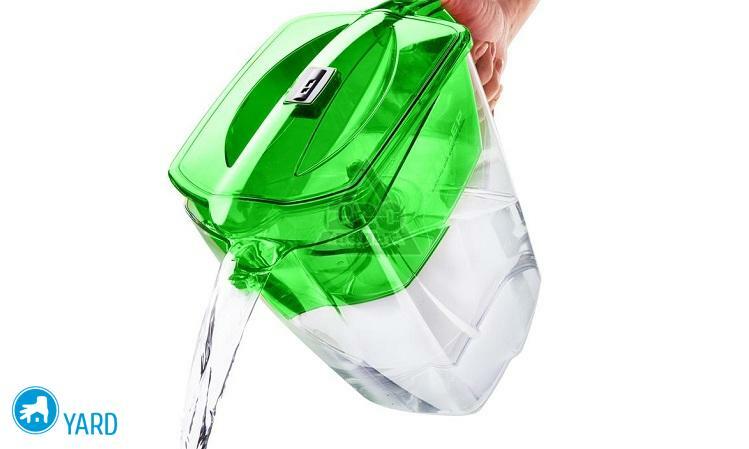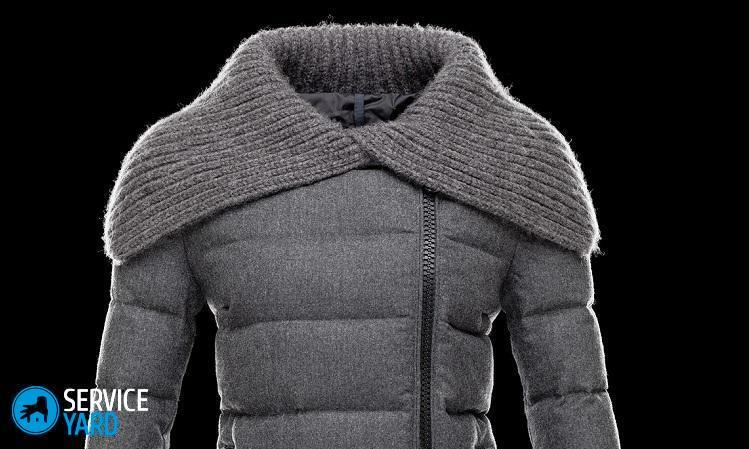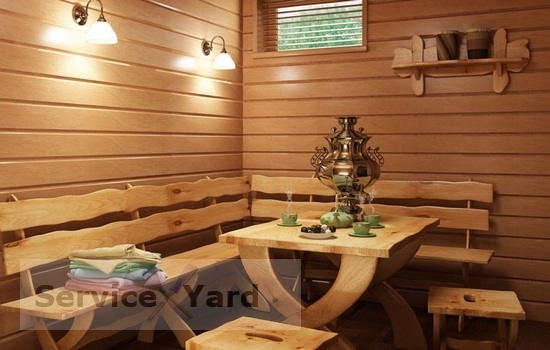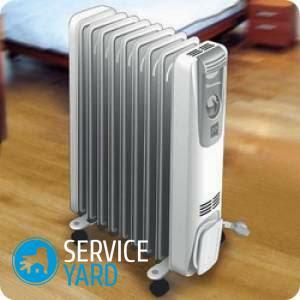
- Device of the simplest oil cooler
- How to disassemble the oil heater?
- Oil heater does not work. Causes and troubleshooting
- Useful advice regarding the operation of the
heater Reliable classic heaters, which are oil heaters, fail very rarely. But still, sometimes breakages happen. Repair of oil coolers sometimes does not require any special skills, so often it can be produced independently at home. How and in what cases is it worth doing - we'll figure it out in this article.
to the contents ↑Device of the simplest oil cooler
To find the cause of the breakdown for a start, it is necessary to orientate yourself in the design of the device. It consists of the following parts:
- Enclosure. It is a hermetic accordion with technical oil inside.
Important! You need to know that inside the oil cooler housing is not only oil, but also a little air.
- At the bottom of the device on the side there is a heater. This element also heats the oil. Often it consists of two spirals, which facilitates the adjustment of the power of the device.
- The control and safety unit is located nearby. At the top there is a thermal relay, and so that it does not touch the case.
- Also in the device there is a fuse, which in case of malfunction( for example, oil leakage) switches off the device. Such elements can be disposable wire type and reusable( bimetallic).
- The design has two switches with illumination. For each fit three wires: zero and phase from the heater and ground.
Important! The electric scheme of the oil heater is very similar to the electrical circuit of other household appliances( kettle, iron).
to the contents ↑How to disassemble the oil heater?
The repair of heaters begins with a search for the cause of the malfunction. As a rule, for this it is necessary to disassemble the device. How to do it correctly, so as not to damage the radiator parts in passing, after all, at first glance, it seems that the oil heaters are monolithic and can not be disassembled. First let's see what will be needed to disassemble this design.
Required tools
You may need the following inventory for repairing and servicing the oil heater:
- An object that can be pushed by a plastic panel. It is better that it has the form of a wedge.
- Screwdriver.
- Multimeter or tester.
- Sandpaper.
- Alcohol, cologne or other alcohol-containing liquid.
- Soft cloth.
- File.
- Brush.
Important! Before starting disassembly, the device must be disconnected from the mains and not connected until it is fully assembled.
Disassembly order
Of course, all models of heaters are different, and you can not describe the standard algorithm for parsing the units. But there are some tips that will help you quickly cope with the task:
- To begin with, you should carefully inspect the radiator control panel. If the case has screws and brackets, the disassembly process will begin with them.
- However, often as a fastening of the plastic panel protrudes a spring latch. Walk around the entire perimeter of the panel with a wedge-shaped object made of plastic or any other material. Do this carefully so as not to scratch the case. It is possible to determine by touch where the latch is. Pressing on this place it is possible to bend it more strongly.
Important! If you do not often deal with the analysis of equipment, then use the camera to capture the whole process. It is also recommended to spread the bolts and nuts in a row during the disassembly. So you can easily assemble the device after the repair.
But do not rush to disassemble the device for heating. Some failures can be diagnosed without looking inside the device.
to Contents ↑Oil heater does not work. Causes and troubleshooting of the
In some cases, you can repair the oil cooler yourself. Let us consider the main breakdowns of such devices and the algorithm for subsequent actions.
Important! When repairing the oil heater, observe all safety precautions and follow the operating instructions of the device and the manufacturer's instructions. Violation of any of the items may result in injury.
Extraneous noises
Often after falling or staying on the heater for a long time, under the slope, it starts to crackle or hiss during operation. This is one of the cases when it is not necessary to disassemble the device. During an incorrect position or due to a blow inside the device, air and oil are moved.
Troubleshooting - It is necessary to put the device in a vertical position for several days. After such a problem should be eliminated by itself.
Electrics
If the appliance does not respond to power on, does not heat up, or even the indicator light comes on, try to connect the power cord to a different outlet first. Perhaps the cause is in a faulty outlet. If the radiator has broken, then with the help of a multimeter it is necessary to check the serviceability of the electrical part of the device.
Important! If you feel the smell of burning while operating the heater, immediately turn off the device from the outlet. Search for the causes of malfunctions should be started only after the device has cooled down completely.
Troubleshooting:
- Check the sockets and plugs. Examine if there is a short circuit between the elements of the heater, because often the cause of such a malfunction is the burnout at the junction of the wire.
- The de-energized radiator must be checked for operation of all switches on the circuit breaker. This can be done using a multimeter or a tester. In the on position, the ends will short-circuit, and in the off position - nothing.
- It is also necessary to check the thermostat with a multimeter. A short circuit should be absent, and resistance should be small.
The remaining faults associated with this problem can only be detected by disassembling the case:
- Inspect all contacts in the control unit - they can oxidize, burn out or loosen. In this case, the repair of the oil heater is reduced to treating the contacts with alcohol. Weakened contacts with a screwdriver should be tightened, oxidized - wipe the nest and isolate.
Important! The most heat-resistant insulation is glass-fiber insulating tape, which can withstand temperatures of up to 200 degrees.
- In the end, check again for a short circuit. Perhaps this will be the end of the repairs. If after the described actions the device did not work, you should look for a breakdown in another place.
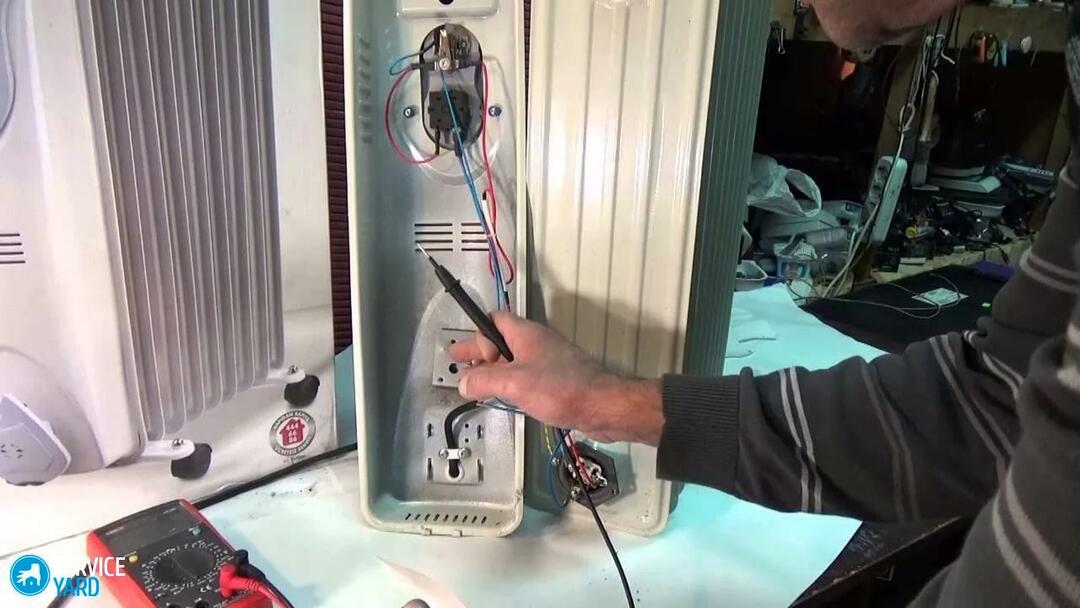
Thermal fuses
These important parts in the heater can be several. If one of them comes into disrepair, then the device stops working.
Troubleshooting - It is necessary to ring and thus find a faulty fuse. The non-working part must be removed, the wires insulated and connected.
Important! This procedure is safe if there are several safety elements in the heater. If a single fuse is out of order, then it should be replaced by a new one, a working one.
Bimetallic plate
The plate can be deformed during operation. This often causes the oil to leak from the appliance. In this case, replacement of the damaged item is required.
Troubleshooting:
- Disassemble the temperature controller.
- Set the heating temperature to minimum.
- Remove the regulator knob from the screw, unscrew the nuts and remove the frame.
- Remove the deformed plate and install a new one.
Oil leakage, tank repair
If you notice oil leaks from the heater, then - the tightness of the body is broken.
Troubleshooting:
Repair of oil coolers in this case is a responsible and not always justified. If you decide to do this, then the following should be done:
- Drain the oil.
- Seal the tank using non-soldered solder, but silver, brass or copper-phosphorus. To do this, use the burner.
- It is necessary to clean the edges of the rust seams well so that they firmly "seize".
- During the work inside the tank, pour water. This will protect you from fire. After completion of work, the tank should be dried.
- After the tank has been repaired successfully, the oil must be changed. Use transformer oil for this. It must be remembered that mineral oils are not compatible with synthetic oils.
Important! Waste oil can not be used for radiators. It leads to clogging with a scum TEN.It should be borne in mind that the oil should fill the tank by 90%, the rest of the place should be occupied by air.
Breakage of heating element
This part of the oil cooler is not repairable. If it is broken, then it can only be replaced by a worker. And this is only possible if your heater model has a removable heating element.
Troubleshooting:
- If you can change the heater in your radiator, you should choose a new one, preferably a copper one, which would be identical in power with the old one.
Important! It is worth paying special attention to the joint between the TEN and the hull. The gasket is supplemented with a sealant.
- If the heater is a non-separable element, after flaring and replacement it will be extremely difficult to roll it back.
Drop or position sensor
This part is a weight that ensures the safety of the heater. At a certain angle of inclination of the radiator or its fall, the sensor switches off the device.
To check if this element is functional, put the heater on the floor and call the contacts.
Important! Repair the drop sensor in the event of a malfunction is not recommended. It is best to replace it with a new one.
to the contents ↑Useful tips for operating the
heater To keep the appliance in service for a long time and you have not encountered repairing the heater, several rules for its use should be adhered to:
- You can not dry clothes on the heating appliance. Undoubtedly, it will quickly dry on the body of the unit, because its surface can be heated to 100 degrees. But this can also lead to a breakdown of the radiator, since the heater will not be able to deliver heat to the room through blocked access, and all internal parts will overheat. If you want to dry the laundry in this way, you need to purchase a special device that is attached to the radiator from above and is designed specifically for these purposes.
Important! Since the surface of the oil cooler can have a high temperature, we recommend placing a special protective screen on it to prevent accidental burns.
- Clean dust from the appliance as often as possible. This will save the equipment from overheating and increase heat emission.
Important! The dust on the radiator can cause an unpleasant smell in the room.
- Do not use the oil heater in rooms with high humidity( bathrooms, showers).
Important! It is worth remembering that the heater dries air, so it is not recommended to use the device in too small rooms.
- Operate the unit only in an upright position. Even storage should take place in consideration of this position of the heater.
Important! In the event that the radiator has spent a long time in a horizontal position, then before you turn it on you must give the device stand upright. Thus, the oil flows down, and the heating elements do not overheat through the lack of heat conductor.
- It is not recommended to use adapters to connect the heater. In this case, incomplete contact is often obtained, as a result of which the unit is turned on and off. There is nothing good for the radiator from this - it can simply burn.
Important! If there is an urgent need in the adapter( this happens, if the socket does not have a European-style connector), then you should buy a really high-quality and reliable conductor.
- And finally a very important point: for safety reasons, do not leave the heater turned on when you leave the house, do not place it near curtains, upholstered furniture or other flammable objects.
As you can see, such simple breakdowns in radiators, such as noise, wire malfunction, oxidation of contacts, can be eliminated at home by yourself. But if after disassembling the heater you find a more serious breakdown than described in the article, then repair of the oil heater is best entrusted to professionals. Listen to the opinion of the master, it may be easier and more profitable to even buy a new device, rather than repair the old one. Observing all safety precautions and the rules for operating oil heaters, you will significantly reduce the likelihood of any problems associated with the operation of the appliances.

